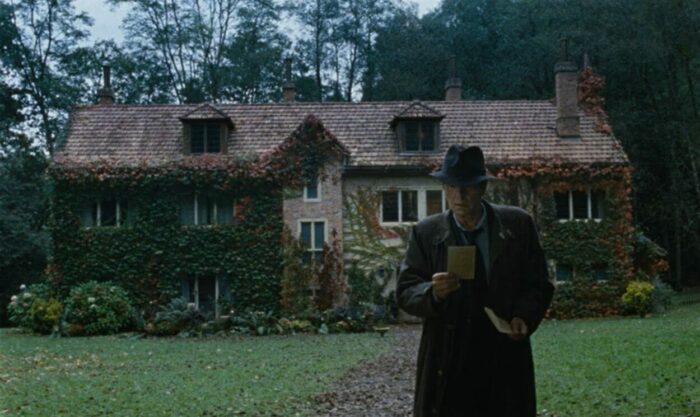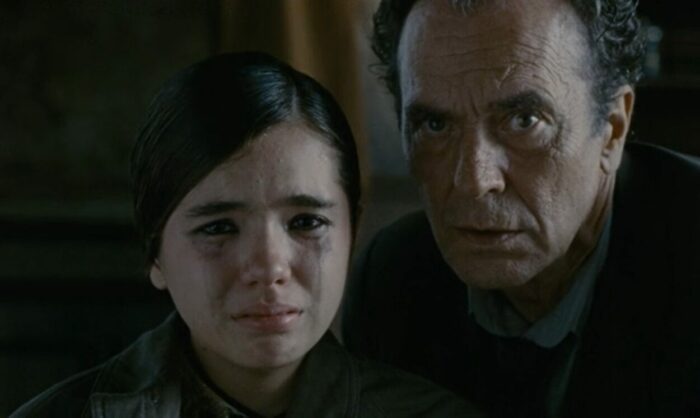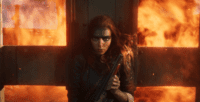Last year’s Cannes Film Festival had a pleasant surprise for the admirers of Víctor Erice who returned with Close Your Eyes—his first full-length film since 1992. Close Your Eyes offers Erice’s take on the past and future of cinema and its ability to make us see the truth even if through fiction. Fiction can be an escape from harsh reality, like I assume it was for Erice’s generation, but it’s an escape to fantasy that can sometimes save lives.
Erice’s films always give a feeling that fantasy and reality don’t exist separately in his world. However realistic Erice’s scenes may be, sometimes with regular people instead of professional actors, his work feels more fabular than realistic: Reality is fictional and fiction becomes real.
All this is true for Close Your Eyes too. After a few minutes into the film, it turns out that what we were watching was a film within a film shown to set the premise for the central story about the missing actor.
Plotwise, Close Your Eyes revolves around the story of an actor, Julio Arenas (José Coronado), who disappeared without any trace in 1990 during the shooting of his last film—“La Mirada del Adios”—the sequence from which opens the film. Only the opening and closing sequences of La Mirada were made. All the ‘body’ of the film is missing.

Twenty-two years later, a TV show dedicated to the old unfinished cases tries to shine a new light on this case of the missing actor. They invite Miguel Garay (Manolo Solo), the director of La Mirada, for the interview. He was also Julio’s close friend. Miguel looks like an outsider to this world. He stopped directing films after Julio’s disappearance and now lives in a trailer at the seaside, occasionally writing and translating texts about cinema. The story of Miguel and his last film share similarities with Erice and the events from his career. Thus, this character and his unfinished film also contribute to that sense of interplay between fiction and reality.
La Mirada is based on the novel El Embrujo de Shanghai (The Shanghai Spell) by Juan Marsé. Erice was to direct the adaptation of the novel in the 1990s, but the producer canceled the project. (The novel was later adapted into a film by Fernando Trueba.) Like Miguel’s film-within-a-film, Erice’s film never happened either, though for a different reason.
The enigmatic disappearance of Julio caused many questions and resulted in theories about what might have happened. If there is a lack of facts, people fill in thosee gaps using their imagination. It seems like everyone has their own version of Julio. It’s unclear which of these versions are true. Or maybe all of them reveal more about the person who tells them.
Miguel, for example, imagines how his friend might have decided to leave everything behind and disappear without a trace. He has in mind the image of Julio standing as a goalkeeper getting ready for a kick. Perhaps, in Miguel’s eyes, Julio was the one who never feared to face life’s blows. But was he? Do people who have no fear drink to oblivion like, according to what people remember about him, Julio did? Or do they consciously disappear and leave their loved ones behind? However, we never get a clear answer as to whether leaving was Julio’s conscious decision.
While Miguel ruminates about past events, trying to revive his memories, he meets other people connected to Julio. One of them is Julio’s daughter, Ana (Ana Torrent). She remembers a different person—the one who occasionally took her for dinner and then would disappear for a long time. Ana has only one gift left from her father—a doll she initially thought was brought by Father Christmas. In a sense, Julio was like a Father Christmas for her. And the irony is that as you get older, you understand that Father Christmas is just a fantasy. The only real thing about Julio for Ana was his voice which talked to her from the phone.
The fact that Ana is played by Ana Torrent, who 50 years ago played 6-year-old Ana in The Spirit of the Beehive, makes the connection between these two films obvious. Little Ana, who hardly distinguished between real and imaginary, tried to contact the spirit of Frankenstein’s monster by closing her eyes and saying her name: ‘Soy Ana’. The line is repeated 50 years later when Julio’s daughter Ana (although technically not the same character) does the same, trying to connect with her father this time.

This suggests that the monster and the father represent the same thing. Both are largely part of the fantasy, and Ana finds her way of connecting with them, through her inner gaze. In The Spirit of the Beehive, this was Ana’s way to survive a repressive environment. Ana from Close Your Eyes has to hold the image of her father as a fantasy figure. She can only contact him like she would contact a spirit.
But what about the real Julio? To me, it seems that even before his disappearance, Julio had no firm grasp of who he was. This is why he is remembered mostly through his roles: in films, as a father, as a tango teacher, and so on. Julio remains this always absent figure. It feels like he has created an empty space that everyone has to fill in with their fantasy.
I see Close Your Eyes as a metaphor for the lost generations of people, perhaps mostly fathers, unable to find themselves. The emptiness in them affected their children who had to turn to inner monster friends to survive, and who could connect with fathers only through inner dialogue. This theme goes through Erice’s career like a thread connecting all his films. To my understanding, it comes from the reality of Spanish society throughout his life and is made especially evident in direct references to The Spirit of the Beehive. However, being an outsider with limited knowledge of what the life of Spanish society looked like, I try to be careful when making observations about it. It may not be my place to talk about. But it is not entirely possible to avoid when discussing Erice’s films.
That film within a film, La Mirada del Adios, set in 1940s—the period so important for Erice, also touches on the themes of truth and deception. In the opening scene, Franc, Julio’s character is asked by Monsieur Levy, a wealthy man who has not long left to live, to go to Shanghai and find his estranged daughter. Levy wants only one thing—to have her look at him before he dies. He gives the reason—because she is the only one who looked at him differently. All the other people in his life saw only lies and deception. Perhaps, there is a truth in her eyes because he was true and honest with her, and she reflected that truth back.
Here we are getting closer to what cinema has to do with all this. Cinema works as a mirror that reflects life. It shows the times when the film was made. Maybe, just like the eyes, cinema even reflects people’s souls.

Watching Close Your Eyes you have a feeling that Erice looks back to the past—his own life and career, the socio-political past of his country, and the history of cinema. The statue of Janus appears at the beginning and the end of the film. Janus is the Roman God of beginnings and endings, transitions, and changes. It has two faces—one is young and the other is old. One looks towards the future, while the other looks towards the past. It is the ending as well as the beginning.
Close Your Eyes carries a certain nostalgia for the past of the cinema, but also gives an optimistic view of its future. Is cinema still able to do the miracles, or has this ability died with Dreyer, as Max, Miguel’s friend remarks? Max is the film editor who also keeps old celluloid reels. He embodies that nostalgia for the old ways of filmmaking. However, later Max dismisses his own words and calls upon Miguel to quit telling stories and start doing things. This line sounds like a paradox because a filmmaker’s job is actually to tell stories. But what Max means, perhaps, is that Miguel has to let the images do the work, maybe even do the miracle. It looks like, Erice believes that cinema can still do that.
People have dreams and fantasies about the future that are not yet real and there is no certainty that they will become real. But the past has already happened. There are facts. Still, all we have are memories that are not necessarily true either. They may be just as imaginary as the dreams about the future. They are the constructs of our minds, just as fantasies.
The images on the film are more solid than that. They represent the memories unaffected by one’s perception. But according to Erice, they need a spectator: ‘A film doesn’t exist unless it is seen—if there are no eyes to look at the images, the images don’t exist.’ Maybe it works the other way around too: the images affect the viewer.
Cinema reflects the reality of life. But what about the ultimate reality that lives inside us? Can cinema make us direct our gaze inside and connect with our soul? If so, then yes, cinema can do miracles, if not by returning the dead to life, at least helping us find ourselves and feel alive.


